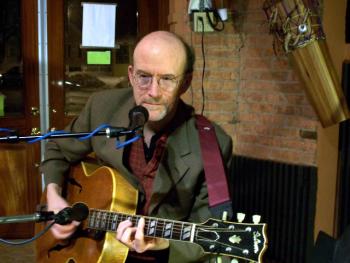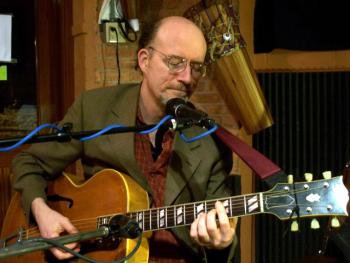Steve Greene's Visit, March 9, 2008
When I arrived at the House of Hamez half an hour early, I was immediately aware that something special was taking place! Several members and guests had already arrived which is somewhat unusual. In addition, a video cameraman was present setting up equipment. Steve was already there busy getting himself and his equipment ready. So, I got myself organized and settled in with James Rowe’s delicious split pea soup and a sandwich ready to take notes.

Steve Greene
Being already familiar with Steve Greene’s (”it sounds so much nicer with the extra “e”!) casual, entertaining, tongue-in-cheek style of entertainment, I knew that it belies his in-depth, sophisticated interpretation of popular standards and jazz tunes. Decades ago, Jazztone, a pre-Columbia record club published an album called “Happy Jazz.” This could be a fitting name for Steve and his work. There were several other professional guitarists present, another indication of Steve’s reputation in the local music community.
Steve began to play guitar when he was ten years old. He clearly remembers enjoying the resonance of an open “E” chord and this being the start of a dialogue of questions with the guitar. He always had the support of his family and had the good fortune to study with some of the old swing masters such as Don Ames and Dick Longale which helps explain some of his penchant for jazz standards. During the seven years that Steve studied with Dick Longale they traded one guitar (the one he was using this evening) back and forth seven times. On one trading occasion this instrument was exchanged for two arch tops and a 13” color-television set after some very skillful negotiation! He has recorded with Gene Bertoncini, written music for the Garth Fagan Dance Company and played in a variety of bands, one of which was called “Mr. Twang” and included Kinloch Nelson. He has taught at Bard College, Hobart College and Hochstein School of Music.
Steve opened the presentation by questioning the audience about their own experience in improvisation. He then let us know that he did not have a nice PowerPoint presentation like Kimo had at the last Guitar Club presentation, but instead handed out two pages of musical examples on how to interpret a simple well-known tune; Frere Jacques, to illustrate his points and said he hoped that this would suffice.
Steve began by saying that to him the most important part of improvisation is the melody. A melody can be improvised upon by adding notes to it, but it can also be varied by omitting notes or introducing silence at appropriate points. All the elements of music can be improvised upon including rhythm, dynamics, tonal color, etc. The melody should always be kept firmly in one’s mind while playing. Steve recommended that we not venture into complicated scales in the early stages of learning, but see what is in the melody and the basic scale it comes from first. Although we tend to play in positions, it can be helpful to play a melody on a single string, sometimes the first or second string leaving the lower strings for chord accompaniment. He illustrated this with his example, Frere Jacques. Once the melody is in your head, you can begin to improvise on it in the various ways suggested.

Tonal color on the guitar can involve the use of various fingers, the orientation of the nail or pick in relation to the string as well as the choice of right-hand position. Picking near the bridge produces a brittle, metallic quality while playing over the fret board delivers a softer, subtler sound quality with variations in between. We can develop our expression by experimenting with the many possibilities available. Half way on the string from the nut to the bridge can produce harmonics. Strings can also be bent with the left hand fingers producing various vibratos . These techniques can be used in chords as well as single note melodies. We should also be aware that sympathetic vibrations can be produced with the open strings not picked and try to use this harmonic effect. Steve (with a smile) then showed us the magic jazz chord that can be played anywhere, any time, in any position. If only I had paid more attention! As Steve tired of talking, he treated us to some of his unique style of playing much to our delight!
Steve also discussed the origins of blues and jazz, beginning with the influence of non-European cultures on European based melodies. In the pedagogy now know as blue notes, typically, lowered thirds and fifths. Modern composers like Stravinsky also had considerable influence on the harmony of popular American music and turned popular songs of the 30’ and 40’s into amazing adventures in chord structuring.
Our audience responded enthusiastically, frequently asking questions and making comments. One common theme that came from our members was the difficulty of overcoming one’s fears and inhibitions when learning to improvise. Steve suggested that we not be too fearful of making mistakes. We should remember that we are never more than a half step away from the right note! He pointed out that he had probably made many grammatical errors while speaking to us, but no one minded or even noticed. The same thing happens musically, it’s just people forming language. Modern technology with perfected recordings has created false expectations. He also recommended improvising verbally by speaking words and phrases out loud as they come into our minds, a kind of stream-of-consciousness before experimenting musically. We have to get beyond playing only for ourselves, but we should take gradual steps, such as playing for the family pet(s) and progressing to children and other family members and friends to help us get over our inhibitions. Once we reach that point, joining a band would be a great learning experience where we could learn to listen to and interact with other musicians.
At one point some one questioned Steve about the common use of arch top guitars rather than flattop instruments among jazz performers suggesting that the flat top has better sound and projection. In his usual good-natured, dry way Steve apologized on behalf of all jazz guitarists for playing the arch top! He then explained that, in his opinion, a good arch top has better projection than a flat top and became popular among acoustic jazz musicians for this reason before the coming of the electric guitar in order to compete with other instruments in the big band setting. All types of guitars have different inherent tonal characteristics and it is up to us to learn techniques to make them sing. So, “Long live all guitars!”
And so, after a pleasant evening of good music, good advice, and good food, we all left the House of Hamez anxious to try out some new ideas on our own. As Steve said in the beginning of the program: “How fortunate we are to be guitarists!”
Steve has an active teaching studio and an interesting website. Here is his contact information:
e-mail: Steve@SteveGreene.com
Website: SteveGreene.com
Phone: 585-271-5006
R. Taglieri
Photos: K. Nelson
Home ::
About Us ::
Events ::
Articles ::
Resources ::
Contact Us ::
Links
©2007-2008, Rochester Guitar Club, All Rights Reserved, This page last updated 2008-04-04 10:38:44
Website by Red Beagle Web Development.








